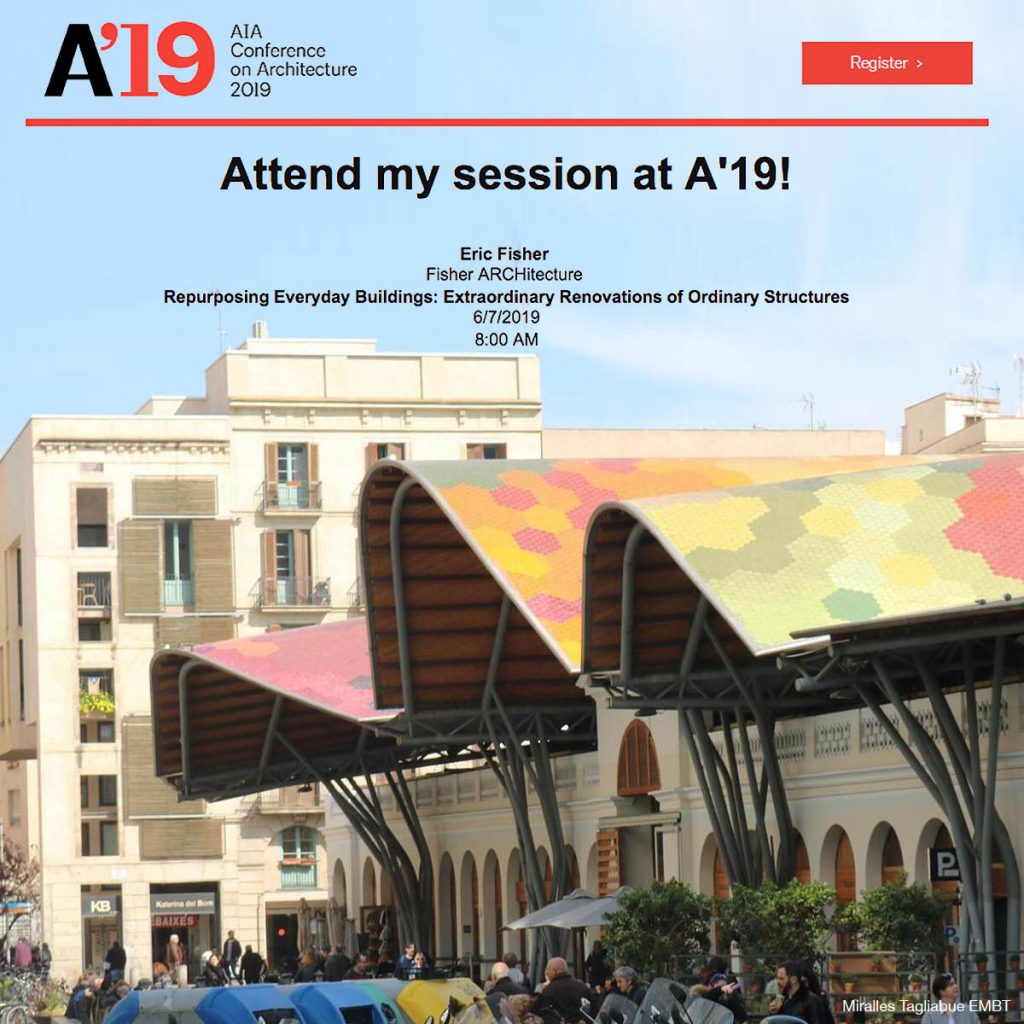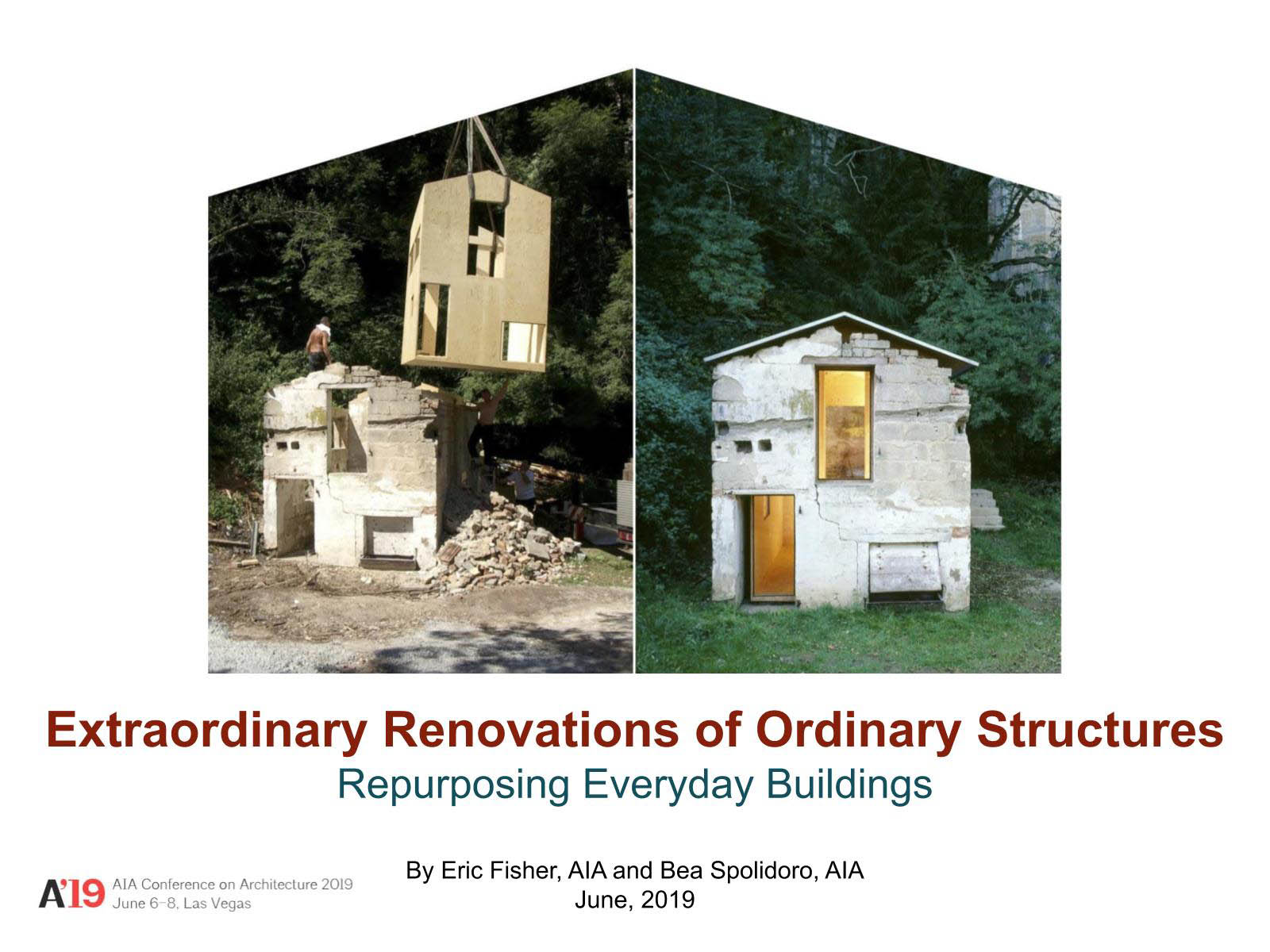Here’s an excerpt from my June 4 lecture with Bea Spolidoro AIA at “The 2019 AIA Conference on Architecture” in Las Vegas. We talked about the advantages of adapting ordinary buildings to new uses:

Repurposing Everyday Buildings: Extraordinary Renovations of Ordinary Structures
6/7/2019
8:00am – 9:00am
1 hour
Las Vegas Convention Center Room N202
Eric Fisher, AIA Principal
Beatrice Spolidoro, AIA Architect and WELL Accredited Professional
“If you are a designer, here are the arguments WE make to stakeholders in favor of adapting ordinary buildings:
1) Flexibility: Ordinary buildings are easy to reinvent often due to their smaller size and less attachment from the community. No one cares what you do with them! You can take a saw to the walls and no one cares.
Ordinary buildings can change in response to new needs and desires in ways not possible with other strategies. In these fluid times, we have a variety of needs. Buildings need to bend and swerve in response to changing conditions. Both developers and owners love this. Also, ordinary buildings typically have neither historic preservation needs nor other code-related constraints.
2) Cost savings: My personal experience has taught me that adaptive reuse projects save money, ESPECIALLY when the existing building is ordinary. Yes, there are costs incurred by having to build around tricky existing conditions. But by preserving the existing foundations, walls, and roof of a building you save the cost of having to replace them. And when you adapt an ordinary building you are free to make creative choices that can save money in unexpected ways.
3) Adaptability: When an architect adapts an ordinary building, he or she is free to focus more on function and experience than on style. This frees the architect to do whatever he wants. Inventive folk prefer them. These are not ducks.
4) The past, and the palimpsest of time will be preserved!
5) “Cradle to Grave” energy use: Buildings use huge amounts of resources. Our planet simply can not afford to tear down buildings once they are obsolete, especially the 95% that are ordinary! This is a true statement. However, my experience has taught me that some stakeholders care. Others don’t…
6) Slowing down perception: And here’s a benefit to end on that appeals to thoughtful folk: Adaptive reuse projects have the benefit, in a world where days pass like minutes, of slowing down perception. This effect occurs whether or not the original building is custom.
The brain understands and processes forms quickly. As a result, we consume forms instantly, as though they are M and M’s. The issue is that most architects’ new designs have meanings that are extremely diffuse. The complexity and contradictions of strong adaptive reuse projects, with their emphasis on communicating the passage of time, make us pause and reconsider our own place in the universe. Look at all the small details of this former brewery transformed into a hotel. Look at the depth of the spatial experience.
“Starchitect” buildings are doing designers no favors in this regard. Many among the small community of critics and educated people who actually care a lot about good design follow only the latest trends. The result is that buildings that don’t resemble those being published are often ignored. Architecture has a two thousand year history. Our opinion is that we shouldn’t just design reflexively in response to the latest trends and tech.
 For visitors something uncanny occurs when visitors experience the skilled adaptive reuse of an ordinary building: “Here complexity slows things down.”
For visitors something uncanny occurs when visitors experience the skilled adaptive reuse of an ordinary building: “Here complexity slows things down.”
Because, as Sartre once wrote, we always project ourselves onto our surroundings, the best of these projects make up a new kind of vicarious human experience. At their best, they form an architecture that represents hope, hope that is borne from the successful resolution of past and present. These projects are experiential objects that disrupt daily life just enough to make one believe that there is more to our days than the humdrum
Critics and creative, young architects used to reject adaptive reuse projects. Why? It used to be imagined that we could reinvent our profession with every line that we drew. This was an idealistic point of view for sure – good for us – but it was also willfully naive. Our belief is that Universities are not educating us to TRULY understand history because they are not teaching students how to relate to it with their designs. I review student portfolios all the time and have never seen an adaptive reuse project!
The reality is that architects ALWAYS must react with or against something: As the critic Alberto Perez has written, “There is no architectural ex-nihilo creation.”[2] (meaning out of nothing) This means that architecture is ALWAYS contextual. Far from limiting the solutions that architects (and students!) can create, preserving the past actually expands our vision by creating MORE variables to address, MORE problems to solve.
As the planet becomes filled with existing buildings, and resources become scarce, ordinary buildings are sure to be targeted more and more for adaptive reuse. Why is this? It’s because ordinary buildings lend themselves to the strategy: Adaptive reuse is a flexible, affordable, and sustainable alternative to demolishing ANY building and starting from scratch.”
[1] “Obsolescence: An Architectural History” 2016 p. 115
[2] Architecture as Embodied Knowledge “Journal of Architectural Education” 1984
